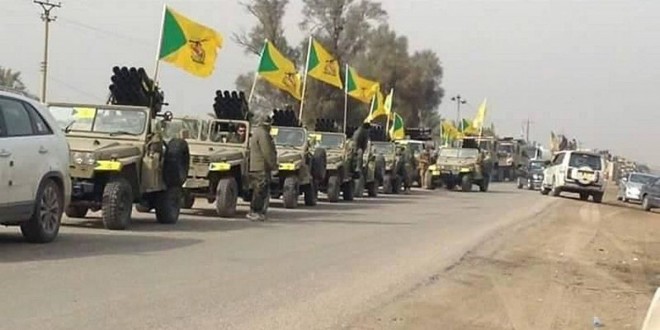With the Islamic State seizing control of much of the Sunni-majority territory in Iraq’s north and west, a de facto Shi’a “Islamic State” could be emerging in the south. What drives this division is fear, which military actors on both sides exploit to cement their power.
In June 2014, a vanguard force of the Islamic State of Iraq and al-Sham (ISIS) seized Mosul – the second city of Iraq – in a daring blitzkrieg assault. They successfully routed two divisions of the Iraqi National Army (INA) and plundered their bases, seizing huge quantities of weaponry, ammunition, military equipment and vehicles. All the while, their numbers swelled as they made common cause with indigenous Sunni armed groups exasperated by the aggressive sectarianism of Prime Minister Nouri al-Maliki’s government. The strengthened force rapidly seized the Sunni Arab majority lands of Salah al-Din, Anbar, Diyala and Kirkuk and advanced to within 20km of Baghdad. In their wake, the 600,000-strong US-trained INA collapsed.
With the INA in disarray, it seemed there was nothing to stop then newly self-titled “Islamic State” (IS) from ravaging the Shia populations of the south. No one that is, except for the divisive sectarian Shia militias known as the “Sons of Iraq”. These groups earned notoriety during Iraq’s bloody sectarian civil-war and more recently in the violent suppression of domestic Sunni resistance movements. Highly experienced and highly motivated, they plugged the gap left by the disintegration and demoralisation of the INA, blocking IS’ routes to Bagdad, Karbala and the Shia heartlands beyond.
As the “Sons of Iraq” squared-off against IS and its Sunni allies, Grand Ayatollah Ali al-Sistani – Iraq’s highest Shia cleric – issued a call-to-arms intended to rally the Iraqi people against this new threat to Iraq’s unity. Tens of thousands of men (estimates vary) answered the call of this “Righteous Jihad” Fatwa: so many that the still-regrouping INA could not accommodate them. As a result, the government announced the establishment of the popular mobilization forces – or Hashd al-Shaabi. In reality, these popular mobilisation forces were no more than inflations of the existing Sons of Iraq militias. The establishment of the Hashd al-Shaabi transformed al-Sistani’s unifying anti-sectarian fatwa into a deeply divisive extension of al-Maliki’s sectarian feudalism. Given the dire performance of the INA, the mostly Shia volunteers were all too eager to enrol in the militias instead.
The Hashd al-Shaabi has led the counter-attack against IS – mostly in the recent massive assault on Tikrit. However, their prominent role in operations serves only to affirm IS’ sectarian narratives and appeal. Moreover, the Iraqi Government may emerge as the biggest loser in the conflict, as the Shia militias exploit their raison d’être of fighting IS to cement greater power and influence over the State – at the expense of the country’s fledgling democratic institutions. If left unchecked, we may soon see the emergence of a de facto Shia “Islamic State” locked in perpetual deadlock with the Sunni “Islamic State” in the north. Indeed, these ostensibly oppositional actors largely mirror one another, with the “Sons of Iraq” and the Hashd al-Shaabi claiming to offer Iraq’s Shias very similar things to that which IS claims to offer Iraq’s Sunnis.
Rationalising the Islamic State’s Iraqi Sunni Appeal:
IS owes its ability to capture and control vast territories in Sunni-majority Iraqi provinces to the compliance of the indigenous population. Indeed, though IS commands media attention with its black-flag-pageantry and slick propaganda, the group actually derives its strength and staying-power through a web of alliances-of-convenience with indigenous Sunni armed groups. Without securing this at least tacit compliance from the indigenous population, the vanguard cadres of IS (approximately 800 fighters at the time of the capture of Mosul according to Iraqi government officials) would have been unable to secure their urban strongholds. IS’ predecessor – al-Qaeda in Iraq – had attempted just that during the US occupation, and had been violently evicted by a Sunni tribal mobilisation.
IS’ 2014 alliances were far from inevitable. In 2013, when IS was first beginning its resurgence in Iraq, it looked likely that history would repeat itself. Although they shared a common enemy – the Shia-dominated regime of al-Maliki – the Sunni population refused to make common cause with the extremists. Despite being involved in an ongoing domestic resistance campaign against al-Maliki, these groups paused their protests in order to aid the Iraqi military in once again expelling the extremists.
It was in this environment that al-Maliki made the critical error that turned the tables on this indigenous Sunni allegiance. Rather than seize the opportunity to promote Sunni-Shia reconciliation through cooperation against the shared jihadist threat, al-Maliki used the IS menace as a veil through which to suppress the domestic Sunni resistance movement. Units of the Shia-dominated Special Forces were diverted on route to IS’ strongholds in Fallujah and Ramadi to clamp down on the protest camps, alongside units from the “Sons of Iraq”. After a series of violent encounters, exasperated leading members of the protest movement called for an armed uprising against the al-Maliki regime.
Iraqi Sunni discontent towards the government had been mounting for a long time. However complaints about corruption, sectarian discrimination and even arbitrary targeting of Sunni political leaders had not been enough to push them into the arms of Sunni extremists. It was the predatory aggression of al-Maliki’s heavily sectarianized security forces – often dubbed “Maliki’s Militia” by the Sunni population – that broke the Sunni camel’s back. The sectarian feudalism crippling Iraq’s security apparatus since the departure of US forces in 2011 marked the most overt illustration of the Iraqi State’s unwillingness to protect its Sunni constituents. This point is critical to understanding how the Hashd al-Shaabi in fact reinforces IS’ hold over its Sunni Iraqi territories, even as the two groups engage in military combat.
Rationalising the mass Shia mobilisation in the Hashd al-Shaabi:
Just as the large-scale embracing of IS by Iraq’s initially resistant Sunni population reflects a widespread rejection of the existing order in Iraq, the mass Shia paramilitary mobilisation that followed al-Sistani’s fatwa and the established of the Hashd al-Shaabi represents an equal rejection by many of Iraq’s Shias. We cannot assume the views and motivations of the Hashd al-Shaabi’s 90,000-plus fighters (spread over fifty militias) to be monolithic. However, in their actions, attitudes and symbolism we can observe a tangible rejection of the Iraqi national project – the US-imposed multi-sectarian democratic order.
For many Iraqi Shias, the resurgence of Sunni Salafi-Jihadism and return to sectarian civil-war in their country, coupled with the humiliating collapse of the INA, is hugely symptomatic and symbolic of the failure of the Iraqi national project. This has been magnified by the forced resignation of the ostensibly ‘secular’ but in reality highly sectarian former Prime Minister al-Maliki. Just as Sunnis feel the Iraqi State is unwilling to provide for them, many Shias are beginning to fear that the Iraqi State is unable to provide for them. For many, the Hashd al-Shaabi may represent a vanguard for a new system of rule in Iraq based on Shia identity and the rule of the Ayatollahs. The comparisons with the Sunni IS are pronounced. Beyond their general exploitation of popular fears, the symmetry displayed by these two military foes is revealed in a number of more specific ways.
Leadership of the Hashd al-Shaabi:
Despite operating ostensibly in cooperation with the Iraqi authorities, most militias of the Hashd al-Shaabi are unabashed about their real loyalties. The Khorasani Brigade, Kata’ib Sayyid al-Shuhada and Harakat al-Nujaba, for example, all openly swear loyalty to Iranian Grand Ayatollah Khamenei. Similarly, the United States Institute of Peace has assessed that the largest militias – including the Badr Organisation and Asa’ib Ahl al-Haqq – appear to take their orders directly from Iran. This conclusion aligns with statements from several members of the Iraqi government, with one Shia MP, Dhiaa Asadi, asserting that the Hashd al-Shaabi cooperates with the INA, “but they have their own commands.” Another senior Iraqi official clarified this, asserting that Iranian Quds Force commander Qassem Soleimani has taken over command of Iraqi military operations following the collapse of the INA, with the Hashd al-Shaabi militias reporting directly to him.
Though not all Shia militias declare loyalty to the Islamic Republic, the theme of religious authority is fairly constant. Liwa al-Shabab al-Risali, for instance, claims legitimacy through Najaf-based cleric Ayatollah Muhammad al-Yaqoubi, while the Peace Brigades follow Muqtada al-Sadr – a descendent of one of Iraq’s most prestigious Shia clerical families.
The fact that the majority of Shia volunteers are choosing to join these openly Shia Islamist paramilitaries over the INA is telling, and may reflect a widespread desire to see a Shia theocracy established in Iraq in the model of the neighbouring Islamic Republic in Iran (if not direct annexation). Such a State would belligerently mirror the Sunni “Islamic State”.
Symbolism of the Hashd al-Shaabi:
Supporting this assessment is the heavily sectarian symbolism adopted by Hashd al-Shaabi units. Militia-led military operations against IS are given names with overtly Shia overtones. The Badr Organisation’s operation against IS in Jurf al-Sakhr was dubbed “Operation Ashura”. Similarly, the ongoing operation against Tikrit – which is being spearheaded by 20,000 Shia paramilitary fighters – has been dubbed “Operation Here I am, Messenger of God”.
Shrouding military operations in religious semantics is a consistent trait among the Sunni IS. In a similar vein is the pageantry of the Hashd al-Shaabi. In the same way that IS flies under its now distinctive black flag (a resurrected relic of the medieval Abbasid Caliphate which toppled the Shia Fatimid dynasty), the Hashd al-Shaabi fights under its own religious banners depicting the martyred Imam Hussein – the definitive symbol of Shia grievance against the Sunnis. Such flags and other imagery are not only overt expressions of Shia solidarity. They may also represent a defiant statement against IS – a warning that the Shia are stepping up to the Sunni sectarian challenge and perhaps bringing their own rival Islamic State to bear against this new “Abbasid Caliphate”.
Conduct of the Hashd al-Shaabi:
Finally, the Hashd al-Shaabi’s conduct is highly indicative that the movement may be attempting to craft a rival Shia Islamic entity in Iraq – one intended to supplant the rejected Iraqi nation-state project. Even before the formation of the Hashd al-Shaabi, Shia militias in Iraq developed a reputation for sectarian violence – and this has only escalated since IS seized Mosul and its surroundings in June 2014. Human Rights Watch (HRW) and Amnesty International have decried these mass killings and persecutions as collective punishments against the Sunni community. However, these attacks may constitute more than mere revenge.
HRW have documented wide-spread eye-witness testimonies accusing Shia paramilitaries of preventing Sunni refugees from returning to their homes after the fighting has subsided – often burning Sunni residences to the ground. HRW spoke to a Health Ministry doctor alongside a Peshmerga officer who both asserted that the Hashd al-Shaabi are methodically attempting to alter the sectarian demographics of the areas they re-capture from IS. The implication is that they are attempting to create a homogenous Shia territory under militia control.
A Symbiotic Relationship – Hashd al-Shaabi and the “Islamic State”
It was the sectarianism of the Iraqi security services that first prompted Iraq’s reluctant Sunnis to embrace the protection of IS. As those Sunnis now watch the Iraqi security sector being usurped – or even co-opted – by Iran and its proxies, it can only horrify them further. Moreover it conforms perfectly to one of IS’ key narratives, which cites the empowerment of Iranian proxies such Lebanon’s Hezbollah, Syria’s Peoples Defence Forces and Yemen’s Houthis as symptomatic of Iran’s attempt to divide and subjugate Sunnism. Their need for protection from this growing sectarian aggression will be felt more keenly than ever – making many ready to embrace even the most disagreeable of champions. In return, the tighter that Iraq’s Sunnis cling to such aggressive and disagreeable champions, the more keenly Iraq’s Shias will cling to their own champions – seeking salvation in the militant, sectarian project of the Hashd al-Shaabi as the State continues to appear impotent and outmoded.
Whether or not the Hashd al-Shaabi are successful in their apparent designs, their attempts – real or perceived – directly aid IS’ own attempts to cement a Sunni territorial entity in Iraq. Just as the Hashd al-Shaabi attained and now retains its legitimacy and raison d’être through portraying itself as the last line of defence against IS, the atrocities and apparent sectarian ambitions of the Hashd al-Shaabi serve only to breathe fresh life into IS’ own claims of legitimacy among Iraq’s Sunnis. As one Sunni refugee told Tirana Hassan, “I took my family out to protect them from ISIS […] I didn’t realize that the people who came to fight ISIS were going to be the ones we would need protection from.”
The views expressed in this article are the author’s own and do not necessarily represent ForMENA.
 ForMENA Council for MENA affairs
ForMENA Council for MENA affairs




